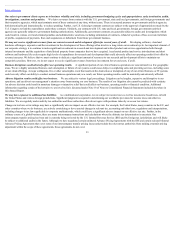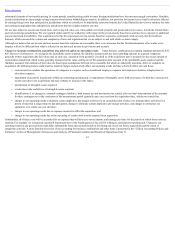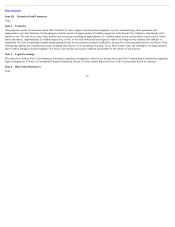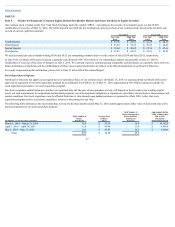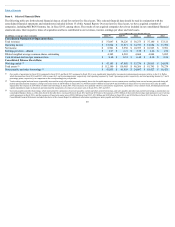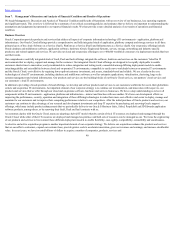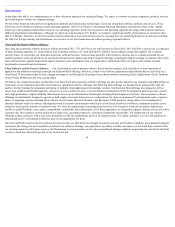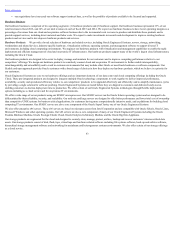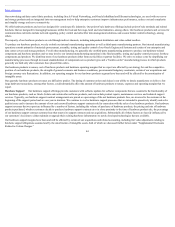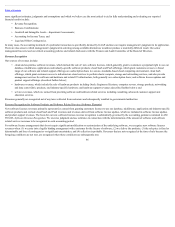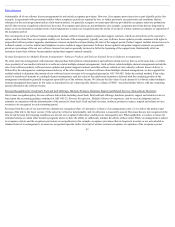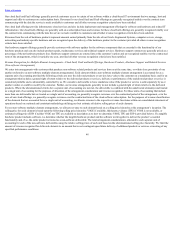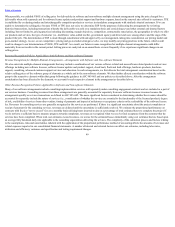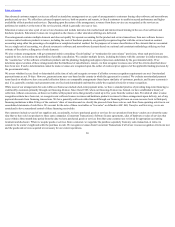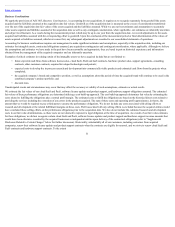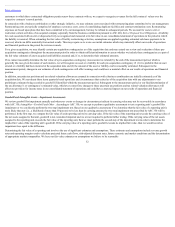Oracle 2015 Annual Report Download - page 44
Download and view the complete annual report
Please find page 44 of the 2015 Oracle annual report below. You can navigate through the pages in the report by either clicking on the pages listed below, or by using the keyword search tool below to find specific information within the annual report.
Table of Contents
PaaS revenues and our new software licenses revenues and the related expenses. We expect these trends will continue. Our SaaS and PaaS arrangements are
generally one to three years in duration and we strive to renew these contracts when they are eligible for renewal. The substantial majority of our new software
license transactions are characterized by long sales cycles and the timing of a few large software license transactions can substantially affect our quarterly new
software licenses revenues.
Cloud software and on-premise software revenues represented 25%, 26% and 28% of our total revenues in fiscal 2016, 2015 and 2014, respectively. Our cloud
software and on-premise software segment’s margin has historically trended upward over the course of the four quarters within a particular fiscal year due to the
historical upward trend of our new software licenses revenues over those quarterly periods and because the majority of our costs for this segment are predominantly
fixed in the short term. As discussed further below under “Supplemental Disclosure Related to Certain Charges,” our cloud software and on-premise software
segment’s margin has been and will continue to be affected by the fair value adjustments relating to the cloud SaaS and PaaS obligations that we assumed in our
business combinations and by the amortization of intangible assets associated with companies and technologies that we have acquired.
Cloud Infrastructure as a Service: Our cloud IaaS segment, which represented 2% of our total revenues in each of fiscal 2016 and 2015, and 1% of our total
revenues in fiscal 2014, provides infrastructure cloud services that are enterprise-grade, hosted and supported within the Oracle Cloud to perform elastic compute,
storage and networking services on a subscription basis. Our cloud IaaS segment also offers Oracle Managed Cloud Services, which are comprehensive software
and hardware management and maintenance services for customer IT infrastructure for a fee for a stated term that are hosted at our Oracle data center facilities,
select partner data centers or physically on-premise at customer facilities.
Software License Updates and Product Support: Software license updates and product support revenues are generated through the sale of software support
contracts relating to on-premise new software licenses purchased by our customers. Customers that purchase software license updates and product support are
granted rights to unspecified product upgrades and maintenance releases and patches released during the term of the support period, as well as technical support
assistance. Our software license updates and product support contracts are generally one year in duration. Substantially all of our on-premise software license
customers renew their software license updates and product support contracts annually. The growth of software license updates and product support revenues is
primarily influenced by three factors: (1) the percentage of our software support contract customer base that renews its software support contracts, (2) the amount
of new software support contracts sold in connection with the sale of new software licenses and (3) the amount of software support contracts assumed from
companies we have acquired.
Software license updates and product support revenues, which represented 51%, 49% and 47% of our total revenues in fiscal 2016, 2015 and 2014, respectively, is
our highest margin business unit. Our software support margins during fiscal 2016 were 91% and accounted for 86% of our total margins over the same period. Our
software license updates and product support margins have been affected by fair value adjustments relating to software support obligations assumed in business
combinations and by the amortization of intangible assets, both of which are discussed further below under “Supplemental Disclosure Related to Certain Charges.”
Over the longer term, we believe that software license updates and product support revenues and margins will grow for the following reasons:
• substantially all of our on-premise new software license customers, including customers from acquired companies, renew their software support contracts
when eligible for renewal;
• substantially all of our customers purchase software license updates and product support contracts when they buy new software licenses, resulting in a
further increase in our software support contract base. Even if new software licenses revenues growth was flat, software license updates and product
support revenues would continue to grow in comparison to the corresponding prior year periods assuming contract renewal and cancellation rates and
foreign currency rates remained relatively constant, since substantially all new software licenses transactions result in the sale of software license updates
and product support contracts, which add to our software support contract base; and
42



